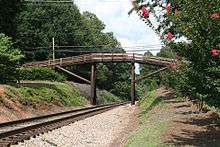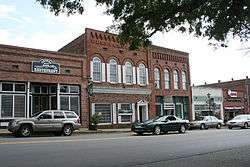Waxhaw, North Carolina
| Waxhaw, North Carolina | |
|---|---|
| Town | |
|
Downtown Waxhaw | |
| Motto: "Proud of Our Past. Passionate About Our Future." | |
|
Location of Waxhaw, North Carolina | |
| Coordinates: 34°55′42″N 80°44′41″W / 34.92833°N 80.74472°WCoordinates: 34°55′42″N 80°44′41″W / 34.92833°N 80.74472°W | |
| Country | United States |
| State | North Carolina |
| County | Union |
| Government | |
| • Mayor | Stephen Maher |
| Area | |
| • Total | 11.54 sq mi (29.9 km2) |
| • Land | 11.54 sq mi (29.9 km2) |
| • Water | 0.0 sq mi (0.0 km2) |
| Elevation | 686 ft (209 m) |
| Population (2010)[1] | |
| • Total | 9,859 |
| • Density | 854.0/sq mi (329.95/km2) |
| Time zone | Eastern (EST) (UTC-5) |
| • Summer (DST) | EDT (UTC-4) |
| ZIP code | 28173 |
| Area code(s) | 704 |
| FIPS code | 37-71460[2] |
| GNIS feature ID | 0996880[3] |
| Website | waxhaw.com |
Waxhaw is a town located in Union County, North Carolina. The population was 9,859 according to the 2010 Census.[1]
Geography
Waxhaw is located at 34°55′42″N 80°44′41″W / 34.92833°N 80.74472°W (34.928201, -80.744835).[4] Stephen Maher is the current mayor of the Town of Waxhaw.[5]
According to the United States Census Bureau, the town has a total area of 11.54 square miles (29.9 km2).Waxhaw is located north of Lancaster, South Carolina and lies about twelve miles south of the Charlotte city limit.
Waxhaw is located in the historic region called the Waxhaws and named after the indigenous Native American tribe that lived there prior to colonial settlement. Waxhaw is in the Piedmont region of North Carolina, which is a wooded area with rolling hills. This region is where gold was first discovered in the United States. The Howie Gold Mine is not far from the city limits.
History

Originally called the Wysacky, the community was settled by European-Americans in the mid-eighteenth century. Most settlers were of German and Scots-Irish origin. Settlers became subsistence farmers and were known for being independent. Andrew Jackson, the seventh President of the United States, was born nearby in 1767. There is some disagreement as to which of the Carolinas was his birthplace because of the proximity of the border.
The arrival of the railroad in 1888 created access to the markets of Atlanta and helped the town reach prosperity. The railroad tracks were laid through the center of town to show the importance of the railroad system to the community. The railroad remains in the center of town and is now bordered by a green grassy strip that divides the rows of stores on each side.
Beginning in the late 19th century, the community began to develop cotton mill factories for manufacturing textiles. The railroad helped increase access for its products. Cotton manufacturing was important to the region through the 1940s. Postwar changes in the economy, with shifts of the textile industry to jobs to other areas and out of the country, required the community to adapt to new conditions.
Waxhaw has evolved as an antique and fine dining center. Its Small Town Main Street committee is working on an integrated approach to developing and marketing the historic center of town. Waxhaw currently has dozens of specialty shops and dining restaurants. Restaurants located in town range from mom & pop restaurants to fine dining bistros. The Waxhaw Historic District is on the National Register of Historic Places. It includes retail businesses as well as architecturally significant houses near the center of town. Also listed is the Pleasant Grove Camp Meeting Ground.[6]
Residents and town officials are working on additional improvement plans. In the downtown area, there is a town park and a skate park for youths. New housing has been built along NC 75 to the east and west of town, as well as NC 16 (Providence Road) to the north.
Near Waxhaw is Cane Creek Park, a 1,050-acre (4.2 km2) park, featuring scenic areas and recreation activities. The facility, on Harkey Road south of Waxhaw, was a cooperative venture between Union County, the Union Conservation District, and the Soil Conservation Service of the U.S. Department of Agriculture.
Demographics
| Historical population | |||
|---|---|---|---|
| Census | Pop. | %± | |
| 1900 | 752 | — | |
| 1910 | 602 | −19.9% | |
| 1920 | 750 | 24.6% | |
| 1930 | 840 | 12.0% | |
| 1940 | 611 | −27.3% | |
| 1950 | 818 | 33.9% | |
| 1960 | 729 | −10.9% | |
| 1970 | 1,248 | 71.2% | |
| 1980 | 1,208 | −3.2% | |
| 1990 | 1,294 | 7.1% | |
| 2000 | 2,625 | 102.9% | |
| 2010 | 9,859 | 275.6% | |
| Est. 2015 | 13,495 | [7] | 36.9% |
As of the census[1][9] of 2010, there were 9,859 people, 3,242 households, and 2,626 families residing in the town. For the population density, there were 854.0 people per square mile (329.95/km²) and 3,517 housing units. As for the racial makeup of the town, there were 78.1% White, 11.00% African American, 2.1% from two or more races, 2.0% Asian, and 0.04% Native American. The Hispanic or Latino of any race was 6.4% of the population.
There were 3,242 households out of which 41.8% had children under the age of eighteen living with them, 81.0% were married couples living together, 10.5% had a female householder with no husband present, and 19.0% were non-families. The average household size was 3.04 and the average family size was 3.41.
In the town, the population age range was from 34.6% under the age of 18, 3.1% from 20 to 24, 32.3% from 25 to 44, 21.2% from 45 to 64, and 7% who were 65 years of age or older. The median age was 34.5 years. For every 100 females there were 93.6 males. For every 100 females age 18 and over, there were 88.8 males.
The median income for a household in the town was $73,188.[1] The per capita income for the town was $27,949. The percentage of people below the poverty line was 8.9%.
Local schools
Public elementary schools
- Kensington Elementary School
- Sandy Ridge Elementary School
- Waxhaw Elementary School
- Western Union Elementary School
- Newtown Elementary School
- Rea View Elementary School
- Wesley Chapel Elementary School
- Marvin Elementary School
Public middle schools
- Marvin Ridge Middle School
- Parkwood Middle school
- Cuthbertson Middle School
Public high schools
- Marvin Ridge High School
- South Providence High School
- Parkwood High School
- Cuthbertson High School
- Central Academy of Technology and Arts (CATA)
Private schools
- Arborbrook Christian Academy
- Omni Montessori School
Special activities
- Although a small city, Waxhaw features annual events that attract visitors, such as, the Fourth of July Parade and the Christmas Parade.
- Waxhaw is close to the headquarters of JAARS, a partner organization of Wycliffe Bible Translators.
- The Queen's Cup Steeplechase races are four miles from downtown Waxhaw
External links
References
- 1 2 3 4 "Waxhaw (town) QuickFacts from the US Census Bureau". United States Census. Retrieved 2012-11-24.
- ↑ "American FactFinder". United States Census Bureau. Retrieved 2008-01-31.
- ↑ "US Board on Geographic Names". United States Geological Survey. 2007-10-25. Retrieved 2008-01-31.
- ↑ "US Gazetteer files: 2010, 2000, and 1990". United States Census Bureau. 2011-02-12. Retrieved 2011-04-23.
- ↑ "Mayor Stephen E. Maher". Waxhaw.com. Retrieved 2016-07-22.
- ↑ National Park Service (2010-07-09). "National Register Information System". National Register of Historic Places. National Park Service.
- ↑ "Annual Estimates of the Resident Population for Incorporated Places: April 1, 2010 to July 1, 2015". Retrieved July 2, 2016.
- ↑ "Census of Population and Housing". Census.gov. Retrieved June 4, 2015.
- ↑ "American FactFinder Census 2010". United States Census Bureau. Retrieved 2012-12-11.
